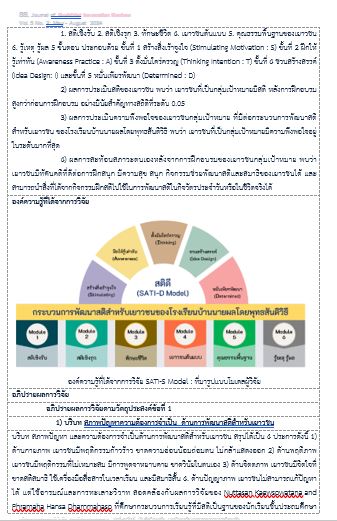The Mindfulness Development Process for Youths of Ban Nai Phol school By Buddhist Peaceful Means
Main Article Content
Abstract
The research article consisted of the following objectives: 1. study and analyze the context, problems, needs, and theoretical concepts related to the development of mindfulness for youths according to modern science. 2. study and analyze the principles of Buddhist peace methods that support the development of mindfulness for youths at Ban Nai Phon School. 3) develop and present the process of developing mindfulness for youths at Ban Nai Phol School by Buddhist peace methods. This is a research and development. The sample group is 25 grade 6 students.
The research results are as follows: 1. The problems of students at Ban Nai Phol School are found to be physical problems, aggressive behavior, lack of humility, behavioral problems, rude speech, lack of self-discipline, mental problems, lack of mindfulness, intellectual problems, inability to solve problems, using emotions and quarrels to solve problems, which are caused by youths lacking mindfulness in their lives. From interviews with relevant persons, including school administrators, teachers, and parents, it was found that it is necessary to solve these problems by organizing training to develop students to be more mindful in their lives. 2. The concepts of modern science theories and Buddhist peace methods used to develop the process of developing mindfulness for youths found that the theories according to modern science include the concept of contemplative studies and Thorndike's theory of associative learning. and the social-intellectual learning theory of the Gestalt group and the Buddhist theory of peace, consisting of the principles of the four foundations of mindfulness and the four principles of meditation. 3.The process of developing mindfulness for youth of Ban Nai Phol School found that the development of mindfulness for youth by organizing training consisted of 6 modules: 1. Receptive mindfulness, 2. Active mindfulness, 3. Life skills, 4. Youth role models, 5: Basic morality, 6: Knowing cause and effect. The results of the training to develop mindfulness for youth found that the youth had higher mindfulness after the training than before the training. At a statistical significance level of 0.05 and the overall satisfaction with the mindfulness development process was at the highest level
The knowledge gained from this research is the mindfulness development process for youth, SATI-D Model, with 5 steps: Step 1. Create motivation (Stimulating Motivation: S), Step 2. Practice awareness (A), Step 3. Set intention (Thinking Intention: T), Step 4. Invite creativity (Idea Design: I), Step 5. Determined development (Determined: D). Teachers in schools can use the mindfulness development process based on the Sati-D Model to organize activities to develop learners to enhance mindfulness in their daily lives.
Article Details

This work is licensed under a Creative Commons Attribution-NonCommercial-NoDerivatives 4.0 International License.
เรื่องลิขสิทธิ์/เป็นความคิดเห็นของผู้เขียน
References
Books:
Mahachulalongkornrajavidyalaya University. Thai Tripitaka edition 1996 Bangkok: Mahachulalongkornrajavidyalaya Printing House.
Phra Phrom Bundit (Prayoon Dhammajitto). (2019). Religion and the Sustainable Development Goals (SDGs). 2nd edition, Bangkok: Amarin Printing and Publishing Public Company Limited.
Yongyut Wongpiromsant. (2014). Creating happiness with mindfulness in organizations (Mildfulness in Organization). Nonthaburi : Beyond Publishing Co., Ltd.
Journal:
Kittichai Suthasinobon. (2021). Development of a Buddhist learning model with mindfulness as a learning base appropriate for primary school students in present-day Thai society. Graduate Journal of Valaya Alongkorn Rajabhat University Under Royal Patronage; (May-August). 15 (2); 40-53 (in Thai)
Nnwaruun Rueangsiri, Phramaha Hansa Dhammahãso. (2021). The Development of Concen-tration and Mindfulness Based Learning Processes: A Case study of The Junior Secondary School Students, Sawaipittayakom, Sawai Sub-District, Prang Ku District,
Sisaket Province. Journal of MCU Peace Studies. 9(3); 988-1000 (in Thai)
Nuttasan Kaewsowatana and Phramaha Hansa DhammahasoThe. (2021). Developmental Process of Mindfulness-Based Learning: A Case Study Upper Primary School at Ban Tha Khoi Nang School Sisaket Provice. Journal of MCU Peace Studies. 9(3); 988-1000 (in Thai)
Pongsun Kasempongsun et al. (2021). The Results of the Learning Activities with Mindfulness and Concentration as a Base for Developing Executive Functions of Junior Secon-dary School Students at Phrommajaksangworn School, Lamphun Province. Journal
of MCU Peace Studies. 9(4); 1472-1484 (in Thai)
Udomwit Thongchua. (2023). The Development to Processes to Promote Family Happiness Based on Buddhist Peaceful Principles. Journal of MCU Peace Studies.(September-October). 11 (6); 2521-2534 (in Thai)
Thesis:
Lamai Buakhan. (2019). Development of learning according to the 4th prayer principle topromote good citizenship according to democratic principles of Mathayomsuksa 4 students at Nong Waeng Wittaya School. Sakon Nakhon Province. Master’s Degree Program Thesis Mahachulalongkornrajavidyalaya University.
Yoksuwan Kaewdok. (2010). Classroom action research by integrating mindfulness and Medi-tation practice to develop desired characteristics and mathematics achievement of Mathayom Suksa 6 students. Master’s Degree Program Thesis Chiangmai
University.


